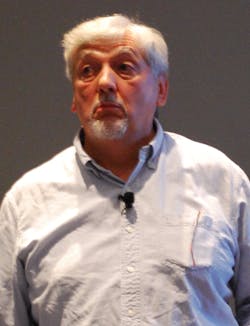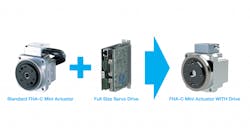Ever feel like your tax dollars are going to waste? Well, that's because they are. Literally.
In communities across the United States, water and wastewater treatment energy consumption accounts for as much as 25% of the municipal budget. And, according to Tom Jenkins, owner and president of the wastewater treatment consulting company, JenTech Inc., 50% to 75% of that money goes to running the blowers that provide air to the bacteria that metabolize waste during activated sludge biological treatment.
This week at the Automation Fair event held by Rockwell Automation in Chicago, Jenkins presented a solution at the Water Wastewater Industry Forum that has proven to recoup a significant portion of that money: switching out the guide-vanes for controlling air flow with variable-frequency drives (VFDs) instead.
Jenkins spends a lot of time thinking about waste in all its forms. In addition to his technical and entrepreneurial bona fides, Jenkins is a member of the ASME committee developing PTC 13, "Wire-To-Air Performance Test Code for Blower Systems" and an adjunct professor at University of Wisconsin, Madison. He also teaches water and wastewater treatment for the Department of Engineering Professional Development program. Jenkins said the idea to swap in VFDs is not new. But it's one that never made economic sense—until now.
A conjunction of factors
"The further you come down the curve, the bigger energy savings you get by using variable-speed control." Tom Jenkins of JenTech discussed how wastewater treatment facilities can substantially reduce electrical energy costs by switching from guide-vane control to medium voltage variable speed drives on aeration blowers.
"This is not a technical breakthrough," Jenkins said. "This is an economic breakthrough, and it's one of those rare opportunities where all stakeholders can come out ahead. The municipality saves operating costs; the design engineers get to have a project that benefits the end user, the municipality; systems integrators have the opportunity to integrate their work into the control system; and the suppliers get to sell VFDs. These are all good things."
Most waste treatment plants in the United States use activated sludge biological treatment. To achieve the proper treatment, you need microorganisms, a food source—the sewage—and oxygen, all together in the right amounts at the same time and place. The bacteria metabolize the waste and settle out of the flow stream leaving clean water. Blowers are used to provide the air that provides oxygen to the bacteria. Too little air and the bacteria die. "But providing too much air doesn't make the process better," Jenkins said. "It just uses more power."
Blowers look a lot like pumps, but they are a lot more complex simply due to the fact that air is compressible and water is not. Pump control by comparison is relatively easy. "Blowers, because of the thermodynamics involved, are not as efficient as pumps. So, 50% to 70% of all the electricity used inside the fence winds up going to those blowers," Jenkins said. "That's a big chunk of the operating budget for a typical municipality."
According to Jenkins, most communities that are larger than 100,000 people use geared, single-stage centrifugal blowers. These are typically 1,000 hp on up, and most of them have high-voltage motors—either induction or synchronous. Generally, these motors run at constant speed, and air flow is controlled by modulating the guide vanes. Variable speed is more efficient that guide-vane control, and can save approximately 10% of energy usage. Blowers, like pumps, operate at their design point maybe five minutes per year, Jenkins said. "Variability of that air supply is critical to optimize the energy of blowers even more so than it is for pumps."
Escalating energy savings
Jenkins said that if you look at the difference between performance curves using guide-vane control and variable speed you will see pretty dramatic differences. "With guide-vane control, as you change the guide-vane position, you remap the blower performance curve just as you would when you change speed with a VFD. But you'll see that the curves don't just drive down parallel like they do with variable speed: They get steeper. The reason they get steeper is because you're sticking something in the airstream: you are throttling the blower as well as spinning the air. If you change the flow by throttling the inlet, you still have the same total pressure rise through the blower; you're creating energy, and losing some of it, because you're throttling it and not just moving the curve up and down."
Altering airflow by varying speed eliminates this inefficiency and provides an average energy savings of 10%, Jenkins said. "At the top of the operating curve, with everything operating full open, they're the same. But the further you come down the curve, the bigger energy savings you get by using variable-speed control."
In the past, variable-speed control was a non-starter, Jenkins said, because the cost of the medium-voltage drives was too high. "It couldn't be justified by the payback in a reasonable period of time. There was no technical reason; it was an economic reason."
Today the economics have aligned to make the switch to variable-speed worthwhile, Jenkins said. He attributes this to three factors: Variable-speed drives have gotten more cost effective because of increased competition and increased technological innovation; energy costs have increased; and VFD reliability has become accepted.
Because of these factors, Jenkins said the payback on transitioning to VFD is three to four years and can be cut to two-to-three years when utility company incentives are incorporated. By Jenkins' estimates, more than 10,000 facilities in the United States could reduce at least 10% of their energy consumption with this solution.

Leaders relevant to this article:






